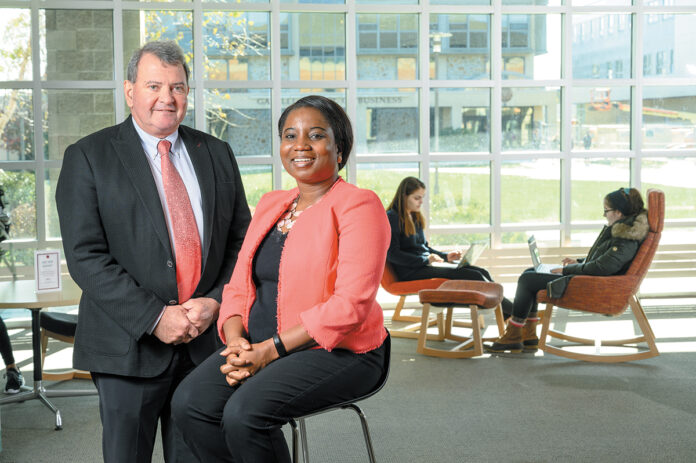
PBN Diversity & Inclusion Awards 2019
EDUCATION: Roger Williams University
Building a mixed community of people – diverse in race, gender, creed and culture – is slow, hard work for any institution. The process, which requires self-reflection and sacrifice, is personal and emotional. It can expose anger and shame.
The work, however, is worth it. A diverse working group is always better than a cookie-cutter culture, said Ame Lambert, vice president of equity and inclusion and chief diversity officer for Roger Williams University.
According to research, Lambert said, “Diversity is always harder to achieve, but heterogeneous groups do better, get better results. They are more creative, more innovative.”
The reason? Groups of people that include unfamiliar individuals are bound to be more uncomfortable, and that discomfort helps the group function better. “They cannot fall back into patterns,” Lambert said. “They are better because they are more tapped into their higher brains.”
Roger Williams University has been seeing continuous improvements in recent years in the diversity of its staff.
A behavior pattern, called statistic discrimination, has made it hard for institutions to open themselves to traditional outsiders, Lambert said. Statistic discrimination says that when making a decision or a choice, we tend to default to what is familiar.
“And that tends to be white males,” Lambert said.
Amy Tiberio, associate vice president of enrollment management and marketing, said diversity in institutions is important because “there are perspectives you cannot be privy to or fully appreciate if it’s not your experience. You don’t know what you don’t know.”
‘If people spend time understanding different experiences, they have a platform for connection.’
Ame Lambert, Roger Williams University vice president of equity and inclusion and chief diversity officer
The university’s full-time workforce now stands at 12% employees of color, a 33% increase from 2016. The workforce is 53% female, 4% higher than in 2016, according to the university.
The improvement is happening because the university is doing heavier recruitment of people from underrepresented groups. Search committees reach out to resources such as the NAACP, Dorcas International Institute of Rhode Island and the New England Higher Education Recruitment Consortium.
Search committees now include equity ambassadors, advocates who continually remind committee members to examine their assumptions about who would make a good hire, including applicants from less-familiar cultures. These ambassadors might step in when committee members get wrapped up in what they consider a typical profile of a job candidate.
“The notion of what is typical has been defined by exclusive institutions,” said Laura Mattoon D’Amore, RWU associate professor of American studies, who has served on these committees. She said a candidate for a dean’s job, for instance, might be rejected because of a lack of certain milestones in his or her career path.
“The equity ambassador might say, ‘Historically, there are people who would not have gotten the opportunity to have those positions, but let’s look at the skill sets needed’ to see if a nontypical applicant has those,” Mattoon D’Amore said.
Roger Williams University has a Women’s Affinity Group, and regular gatherings are held by and for employees of color and LGBTQ groups.
Affinity groups have both outward-looking and inward-looking functions. Partly, they work for change across the institution, and partly they provide respite for people who feel they are always on stage explaining or validating themselves in the larger community.
A Retain Grow Advance leadership academy helps groups that are historically underrepresented in management learn the unwritten rules of advancement in the institution. For instance, a newcomer to the higher-up ranks of the academic world might not understand that a big meeting or presentation is not as important as the conversations before a meeting, or that respecting the chain of command is crucial even when it seems to get in the way. The academy’s inaugural group is 88% women and 27% people of color.
Trying to achieve diversity of race, gender, religion and creed is hard because it requires sacrifice.
“It means, ‘I am dropping a little bit of me to have a little more of we,’ ” Lambert said. “If people spend time understanding different experiences, they have a platform for connection.”












